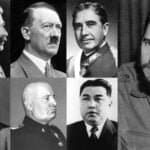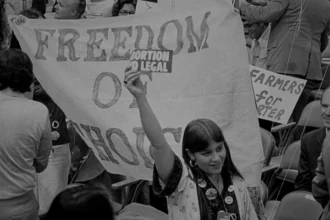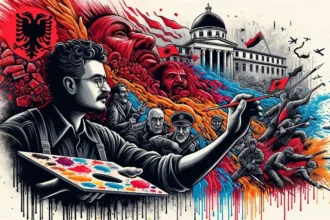Foundations of Albanian War Narratives
Understanding Albania’s political and social landscape between 1944 and 1991 involves a deep dive into how the narratives of war shaped the nation’s collective identity and ideological fabric. The role of war in Albania’s totalitarian past is a critical focal point in this discussion.
Rooted in stories of struggle and resistance, these war narratives offered the Communist Party, born in 1941, a potent tool to legitimize its regime and forge a new national identity. Though this ideology has historical origins that stretch back to 19th-century romantic and revolutionary figures, the Communist Party adopted and adapted these narratives for its own strategic purposes.
The party managed to blend these tales seamlessly into their Marxist-Leninist framework, thereby creating an enduring legacy that connected them with the so-called warrior temperament of the Albanian people. This ideological weaving was so intricate that it transcended mere governance, penetrating every facet of Albanian life from education to the arts.
These war narratives justified the Party’s authority, especially Enver Hoxha’s leadership, and provided a framework that organized both collective and individual experience. Thus, any analysis that aims to unpack Albania’s totalitarian past must consider the multidimensional role that war narratives played in shaping the country’s identity, politics, and social structures.
The Role of War in Shaping Ideology
The ideological landscape of Albania between 1944 and 1991 was deeply influenced by the narrative of a people forged in war. This foundational story has deep roots in Albanian history, going back to 19th-century revolutionaries. These figures sought to inspire a sense of national unity and resistance against Ottoman domination. They often evoked a mythized history of Skanderbeg, a 15th-century national hero who resisted Ottoman forces, using him as a warrior archetype that would embody the Albanian spirit.
The Party effectively melded indigenous myths with foreign Marxist-Leninist ideology.
However, this historical narrative was a living framework that the Communist Party adapted to suit its needs. By embedding itself into this pre-existing meta-narrative, the Communist Party achieved two significant goals. First, it attained a sense of indigenous legitimacy; it was not an external force imposing an alien ideology but was instead deeply rooted in Albania’s own history and culture. Secondly, this positioning allowed the Party to adopt Marxist-Leninist ideology from abroad without appearing to be a foreign imposition.
The meta-narrative also played a role in the Party’s policy-making. The idea of a people shaped by war gave the Party an emotional and ideological foundation on which to build and sustain its rule. In this way, it became both a historical fact and an ongoing political strategy, deeply ingrained in the country’s identity and political ideology.
Communists as the True Successors
The Communist Party masterfully positioned itself as the true inheritor of Albania’s legacy of national heroes and revolutionaries. It was a strategy to monopolize the narrative of accomplishment. Through carefully crafted propaganda, education, and public discourse, the Party drew parallels between its own struggle and the valorous acts of historic figures like Skanderbeg.
The adoption of violence as an ideological norm was a calculated move to cement Albania’s Communist Party authority.
The Party not only amplified these epics but also romanticized them. For instance, embellishing tales of heroism and bravery from the past made the Communist Party’s own triumphs appear even more significant. This created a comparative backdrop against which the achievements of the Party could be measured and glorified. In doing so, the Party achieved a clear monopoly over Albania’s story of struggle and success.
Furthermore, the Party effectively melded these indigenous myths with foreign Marxist-Leninist ideology. By doing this, it achieved a twofold benefit: it localized an otherwise foreign ideology while simultaneously giving it a historical context within Albania. The result was a powerful narrative that granted the Party both indigenous legitimacy and ideological alignment with international communism.
This strategy was more than an intellectual exercise; it was a practical tool. Monopolizing the narrative enabled the Communist Party to shape public opinion, influence education, and ultimately legitimize its rule. It was a blend of psychological, cultural, and political machinations that turned the Party into the perceived true successors of Albania’s national legacy.
War as the Genesis of Communist Ideology
War narratives weren’t merely retrospective for the Communist Party; they also served as its ideological genesis. Narratives of valor, sacrifice, and struggle during war were elevated to the level of myths, contributing significantly to the ideological framework of the Party. By venerating its roots in wartime resistance, the Party achieved something crucial: it made its ideology almost untouchable.
The Party transformed its roots into a form of sacralized history.
This strategic elevation of war as the genesis of its ideology served to perpetuate the Party’s rule. It crafted a narrative that gave the Party an almost divine right to govern, rooted in a historical struggle for liberation and justice. This sanctified origin story made it exceedingly difficult for anyone to challenge the Party’s moral or political authority. Therefore, war narratives became a linchpin in the Party’s ideological construct, effectively securing its long-term rule by situating it within a sacred history of struggle and sacrifice.
Just as ancestral war narratives lent indigenous legitimacy to Albania’s Communist Party, they also provided the foundational myth for its ideology. The Party transformed its roots into a form of sacralized history. By sacralizing its wartime origins, the Party achieved more than just an ideological talking point. It embedded this narrative within the collective consciousness, making it a shared national story. It actively shaped how the past was understood and gave it a role in the present, thereby affirming its own authority. Through this sacralization, challenging the Party was akin to questioning a deeply ingrained national ethos.
This mechanism of sacralization served a distinct political purpose: the perpetuation of the Party’s rule. Its leaders understood that the Party’s survival depended on its ability to position itself as an extension of historical inevitability, as the true successor to a long line of resistance and struggle. Thus, the veneration of wartime roots became an essential aspect of its governance strategy, making the Party’s rule seem logical and divinely ordained. The sacralization helped to insulate the Party from critique, firmly lodging it in the role of the nation’s true and rightful leader. Consequently, the notion that the Communist Party emerged from a wartime struggle became an unassailable truth, integral to its long-term governance strategy.
Violence as an Acceptable Means
Following Mao Zedong’s famous adage that political power grows from the barrel of a gun, Albania’s Communist Party didn’t shy away from endorsing violence; it celebrated it. This was more than mere pragmatism. It was a deeply entrenched ideological statement that positioned violence not just as a political tool, but as a societal norm.
This ideological stance had broad implications. First, it made any form of violence perpetrated by the Party or its supporters morally defensible within the framework of their ideology. This wasn’t mere rhetoric; it had a genuine impact on policy and governance. The use of violence was institutionalized, finding expression in purges, state surveillance, and a pervasive police state.
Penalties ranged from social ostracism to imprisonment.
Second, it gave the Party the latitude to impose its will by any means necessary. The regime could resort to violent suppression without needing to justify it because the ideology itself was the justification. This led to the public accepting, if not glorifying, the regime’s acts of violence as extensions of the Party’s ideological purity and commitment.
Third, this normalization of violence fed into a vicious cycle, perpetuating the Party’s rule. The more the Party could justify its violence as aligned with its foundational principles, the less likely any form of dissent could gain traction. By establishing violence as a cornerstone of its ideology, the Party secured its grip on power, diminishing the public’s willingness to challenge the status quo.
In sum, the adoption of violence as an ideological norm was a calculated move to cement Albania’s Communist Party authority. Violence thus became an acceptable means to maintain power and suppress dissent, reinforcing the Party’s ideological and political dominance.
Mobilizing the Masses
The grand vision of the Communist Party was to transform Albania into a true communist utopia. To reach this goal, the Party aimed for comprehensive societal mobilization, targeting not just economic and political structures, but also deeply ingrained cultural norms and even human psychology. The role of war narratives played a pivotal part in this.
To start, the Party framed its transformative agenda as a perpetual conflict against external aggressors and internal societal ‘ills.’ The definition of ‘war’ (luftë) expanded to include campaigns against pessimism, idleness, and foreign influences—elements seen as antithetical to the Party’s vision.
This framing served a dual purpose. First, it instilled a sense of urgency and mission, pressing every Albanian to contribute to the fight. This was not passive participation since the Party demanded active involvement from the masses in achieving its lofty goals. Individuals were expected to contribute through labor, vigilance, and ideological purity.
Second, this war-like mobilization created a mechanism for control. People who failed to contribute were not just shirking civic duties; they were ‘suspects’ or even ‘enemies’ in a grand battle for the nation’s soul. This made punitive actions against them easier to justify. Penalties ranged from social ostracism to imprisonment, thereby ensuring a disciplined and focused societal march toward the Party’s objectives.
The framework of war became a multifaceted tool: it served as a rallying cry, a mechanism of control, and a yardstick for measuring progress. It allowed the Party to weave the threads of nationalism, ideological purity, and collective endeavor into a tapestry that depicted its version of a communist utopia. Through this, the Party sought to marshal every aspect of individual and collective life towards its ambitious, transformative goals.
A Comprehensive Strategy
While schools were instrumental, they were only one facet of a multi-dimensional strategy. The regime harmonized various institutions, including media outlets and cultural centers, to effectively disseminate its four ideological cornerstones. These were not stand-alone themes but interconnected cogs in a well-oiled machine designed to maintain ideological control.
The war narrative in Albania from 1944 to 1991 was a deliberate orchestration by the Communist Party.
Media, for instance, magnified historical narratives and present-day accomplishments, projecting the Party as the sole architect of Albania’s progress. Newspapers, radio broadcasts, and later television, provided daily affirmations of the Party’s ideologies. They celebrated ‘victories,’ whether over nature’s challenges like droughts or over ideological enemies, thereby reinforcing the idea that the Party’s war was ongoing and necessary.
Cultural centers and public events, such as parades and festivals, also played their part. Here, the national archetype was lionized through performances and artistic portrayals, connecting the Party’s narrative with deeply rooted cultural expressions. Meanwhile, speeches and publications from Party leaders served to reiterate the essential role of violence and purification in the march toward a communist society.
This comprehensive strategy ensured a consistent and pervasive ideological message. By controlling narratives across multiple platforms, the regime could captivate the public’s attention and direct it toward the goals of the Party. The influence was vertical—from the Party down to the people—and horizontal, permeating society at every level. This network of influence left virtually no room for alternative viewpoints, making the Party’s war narratives persuasive and inescapable.
In Retrospect
The war narrative in Albania from 1944 to 1991 was a deliberate orchestration by the Communist Party. This strategic weaving of historic folklore with Party accomplishments secured their grip on power and shaped national identity. Their use of an indigenous war-based meta-narrative as the fabric of a broader Marxist-Leninist ideology had two immediate outcomes: it provided indigenous legitimacy and facilitated ideological alignment with international communist narratives.
Moreover, this case study serves as a compelling lesson on the manipulation of historical memory and identity for political ends. It offers a glimpse into how a totalitarian regime can twist cultural narratives to legitimize violence, suppress dissent, and mobilize a nation toward a specific ideological future.
In sum, delving into this dark chapter of Albania’s past is not just an academic endeavor. It’s a necessity for human rights advocates, policymakers, and anyone committed to preventing the reemergence of similar oppressive ideologies. By dissecting the methods used to manipulate collective memory and mobilize society, we gain valuable insights that can inform resistance to human rights abuses and the erasure of democratic principles in the present and future.









